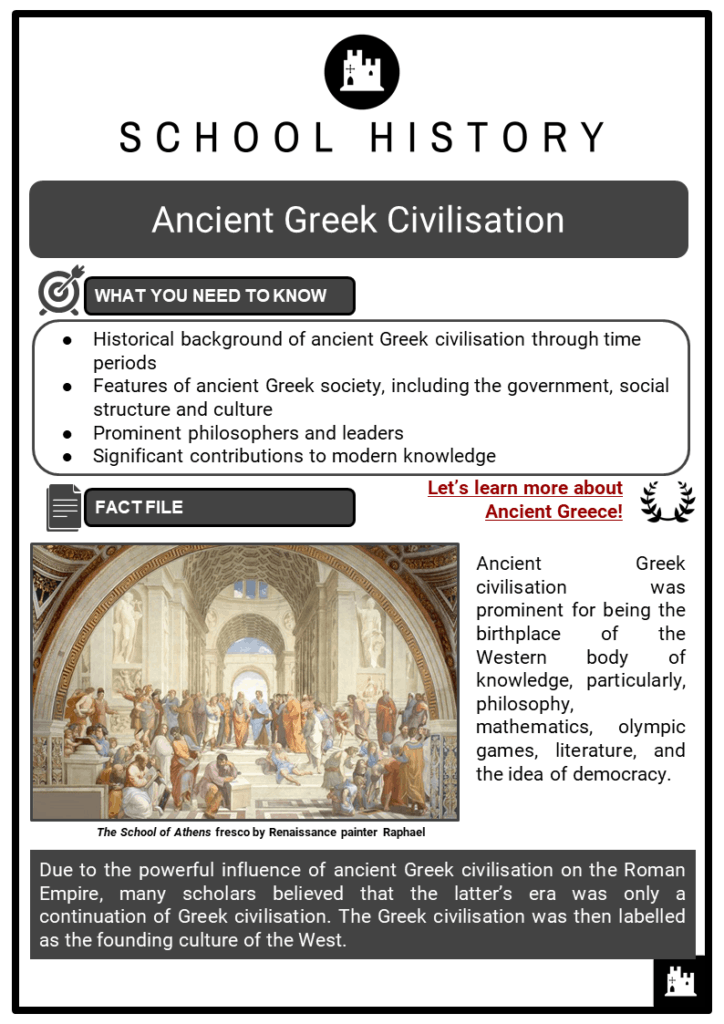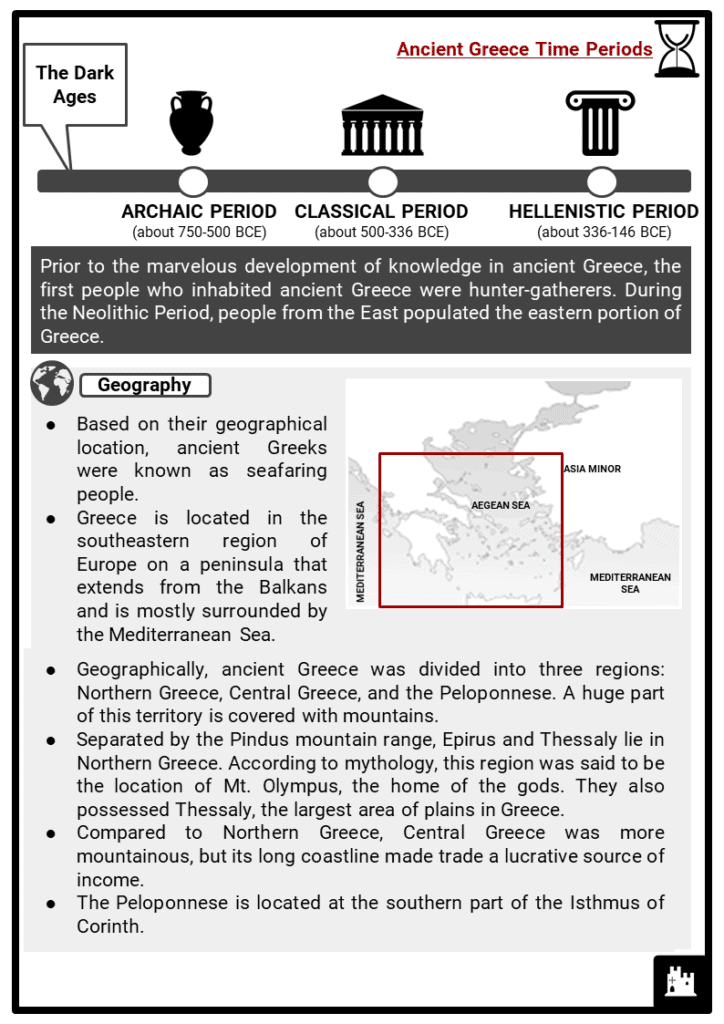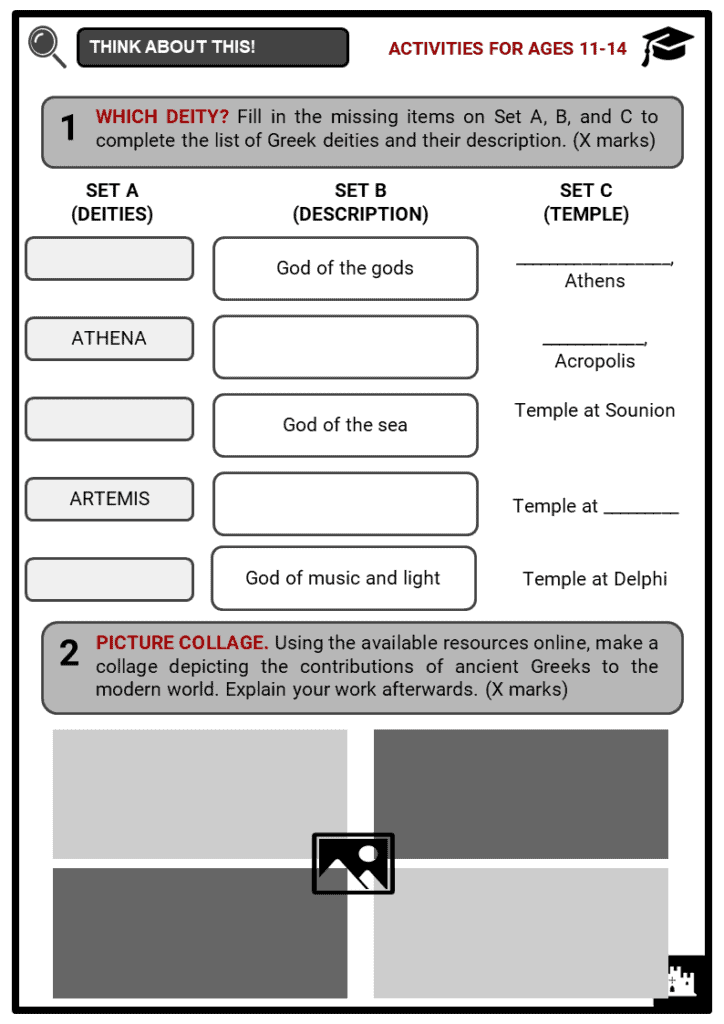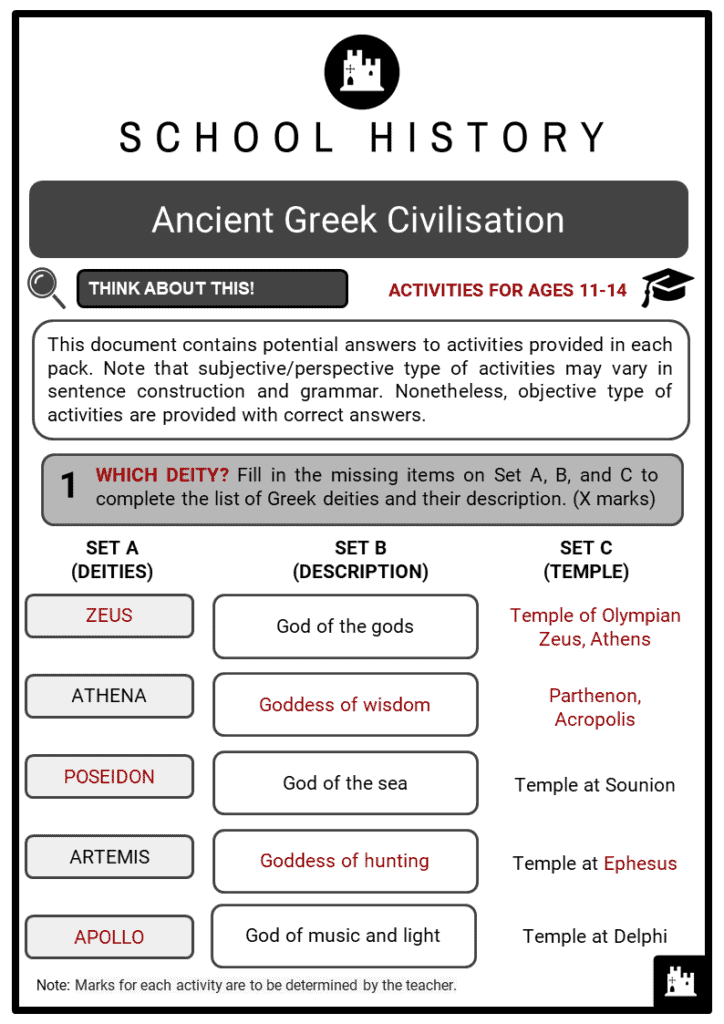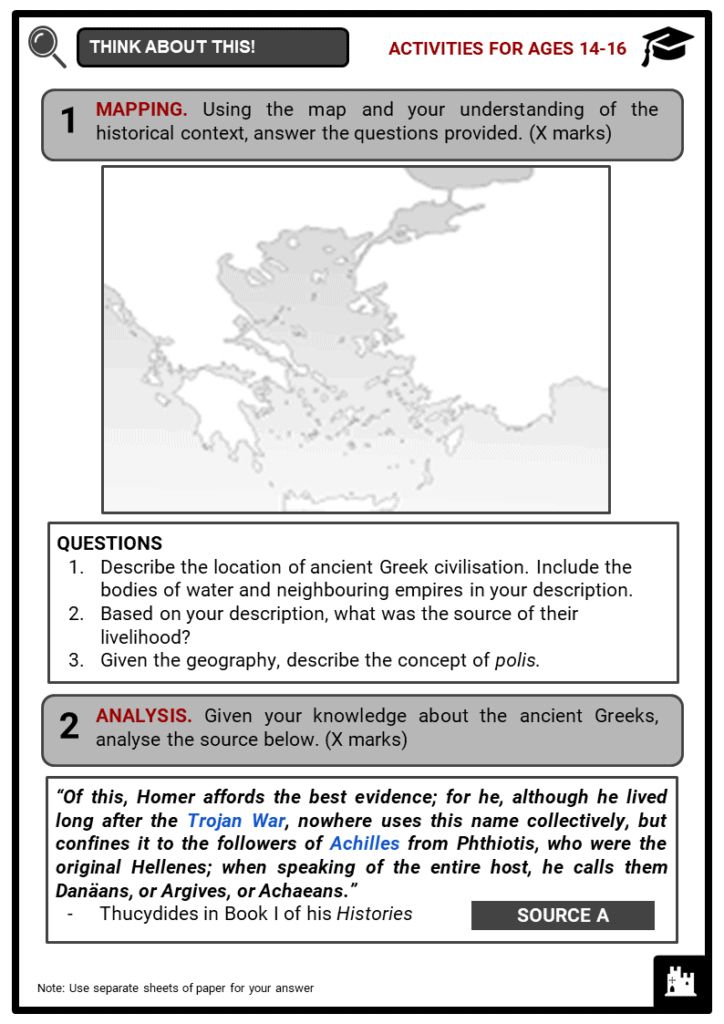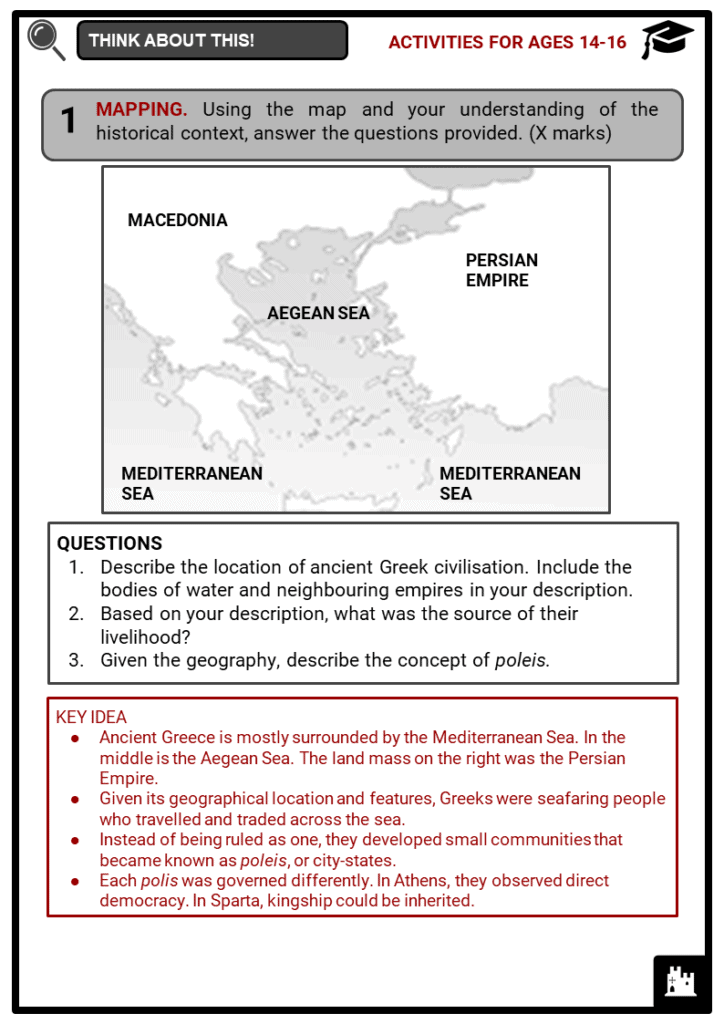Download Ancient Greek Civilisation Worksheets
Do you want to save dozens of hours in time? Get your evenings and weekends back? Be able to teach Ancient Greek Civilisation to your students?
Our worksheet bundle includes a fact file and printable worksheets and student activities. Perfect for both the classroom and homeschooling!
Table of Contents
Add a header to begin generating the table of contents
Summary
- Historical background of ancient Greek civilisation through time periods
- Features of ancient Greek society, including the government, social structure and culture
- Prominent philosophers and leaders
- Significant contributions to modern knowledge
Key Facts And Information
Let’s learn more about Ancient Greece!
- Ancient Greek civilisation was prominent for being the birthplace of the Western body of knowledge, particularly, philosophy, mathematics, olympic games, literature, and the idea of democracy.
- Due to the powerful influence of ancient Greek civilisation on the Roman Empire, many scholars believed that the latter’s era was only a continuation of Greek civilisation. The Greek civilisation was then labelled as the founding culture of the West.
Ancient Greece Time Periods
- Prior to the marvelous development of knowledge in ancient Greece, the first people who inhabited ancient Greece were hunter-gatherers. During the Neolithic Period, people from the East populated the eastern portion of Greece.
Geography
- Based on their geographical location, ancient Greeks were known as seafaring people.
- Greece is located in the southeastern region of Europe on a peninsula that extends from the Balkans and is mostly surrounded by the Mediterranean Sea.
- Geographically, ancient Greece was divided into three regions: Northern Greece, Central Greece, and the Peloponnese. A huge part of this territory is covered with mountains.
- Separated by the Pindus mountain range, Epirus and Thessaly lie in Northern Greece. According to mythology, this region was said to be the location of Mt. Olympus, the home of the gods. They also possessed Thessaly, the largest area of plains in Greece.
- Compared to Northern Greece, Central Greece was more mountainous, but its long coastline made trade a lucrative source of income.
- The Peloponnese is located at the southern part of the Isthmus of Corinth.
Before the Dark Ages
- As hunter-gatherers, people who occupied the eastern region of Ancient Greece established settlements and domesticated animals.
- By the emergence of the Bronze Age, people of Crete, the Aegean Islands, and other island settlers melted metals for ornaments, jewelry, swords, etc.
- Between 2000 and 1400 BC, Crete gave birth to the Minoan Age. Known for their pottery and sculptures, the Minoans constructed a number of palaces and devoted most of their time to the arts.
- Today, ruins of many palaces in Crete constructed by the Minoans are still visible.
- By 1100, the peaceful Minoans were attacked by the Mycenaeans, which put an end to their era. However, art and sculptures still flourished, as seen in the construction of bridges and more palaces and buildings.
- Between 1100 - 750 BC, Ancient Greece entered the Dark Ages. Following the Trojan War, the Mycenaeans were conquered by the Dorians.
- The Dark Ages solidified religion and mythology among the ancient Greeks.
Archaic Period
- Succeeding the Dark Ages was the Archaic Period, which was characterised by the development of art, particularly pottery and sculptures. After the fall of palaces (Mycenaean civilisation), people in Ancient Greece abandoned the cities and formed small tribes instead.
- Some chose to be nomadic, while those who remained to develop farming societies later developed city-states, or poleis. In 800 BC, with the emergence of lucrative trade between communities, they began to build fortifications for defense.
- Historians regard the Archaic Period as the time of rebirth in Ancient Greece.
- By 776 BC, the famous Olympics began in Elis, a region of Peloponnesus. Every four years, all Greek-speaking people sought the opportunity to join the Olympic Games and showcase their physical strength. This public contest was a chance for winners to be considered as heroes in their city-states.
- The Olympic games in Ancient Greece was part of a festival to honour Zeus. According to Greek mythology, the games were founded by the son of Zeus and Alcmene, Heracles.
- The initial events included stade (192-metre race), diaulos (400-metre race), dolichos (long-distance race), wrestling, pentathlon, long jump, javelin throw, discus throw, and chariot race.
- Also during this period, Greeks used their seafaring skills to colonise territories outside the Aegean Sea.
- Among their initial colonies were the Bay of Naples in 750 BC and Syracuse in Sicily. Due to scarce farmlands and an increasing number of people, the Greeks sought new opportunities.
- After the reopening of trade with Egypt and contact with Mesopotamia, the Greeks adopted the coinage system of the Lydians of Asia Minor.
Classical Period
- The Classical Period started with an Ionian rebellion against tyrannical Persian rule. With the help of Athens and Eretria, Ionia was able to defeat the Persian troops. Years later, the Persian ruler, Xerxes, attempted to conquer northern and central Greece city-states. However, Sparta, Athens, and several other states launched war to resist the Persian expansion.
- In 480 BC, the battle of Thermopylae took place. About 300 hundred Spartans were led to Central Greece.
- The tension did not cease between Athens, Sparta, and Persia, which resulted in numerous battles and wars throughout Greek history.
- Athens ended the war against Persia in 450 BC, because it was crushed while attempting to defeat Egypt.
- Even though Persia and Athens were no longer at war, tension between Sparta and Athens increased. However, this conflict soon ended with an attempt from Athens to help Sparta with reinforcements, which was declined by Sparta.
- In 446 BC, Athens and Sparta signed a 30-year peace treaty.
- Grecian history recorded a lot of battles and wars at those times. However, by the 4th century BC, Greece was under Spartan control. By 395 BC, Athens, Corinth, Argos, and Thebes declared war against Sparta.
- Great and bloody wars still took place in Greece, and Athens soon began to emerge as the mightiest force. At that time, Alexander the Great defeated Persia and some other countries.
- Aside from bloody battles among city-states and foreign invaders, the Greeks attained remarkable cultural and philosophical achievements during this period. Today’s democratic government was a great contribution of Athens to the world.
- Classical thinkers, including Socrates, Plato, Aristotle, Euripides, and Hippocrates, are still relevant to the current body of knowledge.
Hellenistic Period
- The Hellenistic Period was marked by the end of the wars launched by Alexander the Great. These wars ended with the defeat of Greece. With the death of Alexander the Great in 323 BC, the generals of Alexander divided the Roman Empire.
- Whilst the Roman Empire was in interior conflict, the Greeks gained some freedom. Alexandria and Antioch were the centres of the Hellenistic culture.
- In effect, many Greek youngsters migrated to Alexandria and Antioch.
- Thebes, Corinth, and Argos aligned together, forming a league called the Achaean League. While Sparta and Athens were the Aetolian League, these two were in constant conflict with each other.
- Amidst the conflicts, this period saw the expansion of Hellenistic cultural influence across the Mediterranean region and parts of West and Central Asia.
- Following the philosophical views of classical thinkers, new schools of thought emerged, including the Stoics, Skeptics, and Epicureans. In architecture, previous styles were developed further and in more detail. The Corinthian order was used at the Temple of Zeus in Athens.
- Moreover, the fields of mathematics and science achieved substantial maturity. The works of Archimedes and Eratosthenes in geometry became very influential.
- Finally, Greek leagues formed to combine their powers against the Romans. However, after a bloody war, Greece was totally absorbed into the Roman republic in 146 BC.
- In 146 BC, the Greeks came under Roman rule. The Romans made a province for their empire in Greece, which was known as Macedonia. The Greeks tried to revolt, but they never succeeded. The conquest of Greece was beneficial to Rome, as they learnt a lot from the Greek culture.
Features of Ancient Greek Society
- From the birth of city-states, or poleis, during the Archaic Period, ancient Greeks organised their small communities using a set of laws and were protected by local armies. Aside from their military skills, they also believed that each polis was under the care of certain deities.
Politics and Government
- Due to geographical reasons, Greece was divided into city-states. However, all of these ancient cities shared one religion and culture, and they spoke the same language. Major Greek cities did not seek the country’s unity.
- They believed that every city should be ruled by its own people. Thus, there were numerous wars amongst Greek poleis. Each major state tried to grow in power by expanding and capturing more land and minor cities.
- Overtime, the Greeks were subjected to different forms of government. These included:
- Democracy, which observed rule by the people (male Greek citizens)
- Monarchy, or the rule of an individual through inheritance.
- Oligarchy, which means rule by only a few people, mostly aristocrats
- Tyranny, or an individual’s rule who seized power by force
- In addition to Athens, which was known to be the birthplace of democracy, the city-states of Argos, Syracuse, Rhodes, and Erythrai also shared the same form of government.
How did the Athenian democracy work?
- Council of 500 (Boule)
- Supervised and evaluated the works of the magistrates
- Prepared law proposals of the ecclesia
- Guarded the seal of Athens
- Popular Assembly (Ecclesia)
- Composed of 6,000 citizens, or ecclesiastes
- Voted on law proposals, decrees, and treaties
- Elected military magistrates
- Magistracies (Military and Civil)
- Commanded the military and presided over its affairs
- Presided over family and inheritance law
- Organised feastivities
- Popular Tribunal (Hellala)
- Volunteers chosen by lot of citizens over 30 years old
- Chosen by lot on the day of the trial alone
- In theory, all members of the assembly could speak and actively participate in politics. However, those who emerged as the best and most influential speakers dominated the assembly.
- Other Greek cities followed Athens as a model for a practical and fair political system. However, Sparta remained under the hereditary rule of kingship. They had a council of elders and magistrates who inspected the kings’ rule.
Social Structure
- In Ancient Greece, social class was determined by wealth. Native born males dominated the society. They enjoyed full legal status of a citizen, as compared to women and foreigners, who did not.
- Native free men were the only people considered to be citizens in Ancient Greece. As part of being a citizen, they had the right to vote, hold public office, and own property.
- Women, children (below 18 years old), and foreigners had no rights as citizens.
- Similar to other ancient civilisations, slaves occupied the bottom of the pyramid. They had no social status and were owned by masters. Amidst having few rights, it was banned to kill slaves.
- Most of the slaves were promised freedom by their owners. Freed slaves were not fused with Greek nationality, but they were granted a free will and were allowed to live in Greece as foreigners.
- City-states also owned a large slave force, and these slaves enjoyed more freedom than of those owned by families.
- Male citizens were further divided into three groups: the aristoi, or wealthy and landowning aristocrats; the middle class, which was composed of artisans; and the perioikoi, or farmers.
- Non-resident foreigners were called xenoi, while residents were known as metoikoi.
- Compared to male citizens, women had few rights. They could not own or inherit lands, had no ability to vote, and marriage was decided by their father or male guardian.
- Women were expected to fulfill the purpose of their life - homemaking and bearing children. Other activities included wool-work and weaving.
- Unlike Athenian women, females in Sparta were permitted to own lands and drink wine. They were also encouraged to do physical training like men.
- Women in ancient Greece typically married at the age of 13 or 14. Later, women were taught of music and culture.
Education, Religion, and Culture
- In Ancient Greece, education for the young was highly dependent on one’s gender. Wealth was also a factor, as young girls from rich families were taught how to read at home.
Education
- Athens and most city-states
- At the age of 6, young boys were taught at home and further learnt to read and write when they attended school.
- By the age of 14, boys from wealthy families were capable of being educated in secondary schools with knowledge of natural science, rhetoric, geometry, astronomy, etc.
- Poor young girls were taught housework and motherhood skills.
- Those who came from wealthy families were tutored at home about how to read and write.
- Sparta
- At the age of 7, Spartan government took over the guardianship of young boys. For the next 5 years, they lived in stations for physical training.
- By the age of 18, military training was imposed. At the end of this, a student would become an Ephebe, or soldier.
- For young women, public school catered to physical education. At the age of 18, they were trained how to wrestle, throw a discus and spears, and run.
- They were also taught to sing, dance, and play instruments.
- One of the most well-known schools was the one founded by Aristotle of Stageira. Another school, the Platonic Academy, was founded by Plato.
- The Greek alphabet was not the first writing system of ancient Greeks. They had used the Linear B script, which was influenced by the Mycenaeans. However, this system began to diminish around 1100 BC, the same time the Greek alphabet developed. Based on archeology, the earliest inscriptions of the Greek alphabet were found on pots and potsherds. When Egypt was conquered by the Greeks during the Hellenistic Period, their hieroglyphs was replaced with the Coptic alphabet (based on the Greek alphabet).
Religion
- Ancient Greeks practiced polytheism, meaning they believed in and worshipped several gods and goddesses that represented certain aspects of human life.
- For the ancient Greeks, religion guided their personal and everyday life.
- They believed that their gods and goddesses lived on Mount Olympus. In general, their literature, architecture, and art reflected this belief.
- These deities were depicted in human form and characters. In most cases, they directly intervened in human affairs and could even bear children with them.
- Through the works of Homer and Hesiod, Greek religion and mythology was written.
- There were said to be 12 or 13 deities that comprised the list of Olympian gods. In Greek mythology, these were the major deities that resided on Mount Olympus. The Elder gods, or Titan gods, were the rulers of the cosmos prior to the Olympian gods.
- To honour their gods and goddesses, ancient Greeks built temples, or naos, and designated them as patrons of cities. For example, Aphrodite, the goddess of beauty, passion, and love, was the patron of the city of Corinth.
- Hera, the wife of Zeus, was the goddess of marriage and family. Thus, she was always called upon during weddings. Ares, the god of war and soldiers, was always prayed upon in battles.
- Religious ceremonies to the gods were officiated by priests.
- The temple of the Parthenon, located on the Acropolis of Athens, was built between 447 and 432 BC to honour Athena, the goddess of wisdom.
- It is believed that a massive ivory and gold statue of Athena was housed in this temple. By the 5th century BC, the temple had been looted, and the statue was taken to Constantinople. However, a number of replicas survived during the Roman takeover.
- Despite having less participation in Greek society, women could also be priests and represent the goddesses during ceremonies. Most priestesses were either virgins or beyond menopause.
Literature and Arts
- During the Archaic Period, Homer produced two lasting epics entitled The Iliad and The Odyssey, which centred on the events of the Trojan War and the fate of Achilles, Hector, and Paris.
- Homer’s work gave way to lyric poetry and influenced Roman writers, such as Virgil.
- From oral recitation of poetry, drama emerged during the Classical Period. Outdoor theatres became the venue for plays and tragedies. Sophocles, another playwright, became famous for his trilogy, Oedipus Rex, Antigone, and Oedipus at Colonus. The tragedy of Oedipus centred on a boy killing his father to become king and marrying his mother.
- Philosophers and historians, such as Socrates, Plato, Aristotle, Epicurus, Epictetus, Herodotus, Thucydides, and Plutarch, greatly contributed to Greek literature.
- In architecture, ancient Greeks contributed to the world several distinctive styles, including the five classical orders - Doric, Ionic, Corinthian, Tuscan, and Composite - which were all used during the Roman civilisation.
- In the earlier periods, Greeks used wood and thatch roofs for most buildings. By the late 7th century BC, they preferred to use marble while building columns for huge temples and buildings.
- In addition to the Parthenon, temples to honour Zeus, Artemis, and Poseidon were built in Olympia, Ephesus, and Sounion, respectively.
- Generally, Greek temples were characterised by a rectangular shape and supported with rows of columns.
- Doors were made of high-quality wood, and most of the time, they were decorated with bronze medallions.
- Another work of art of ancient Greeks that continues to impress spectators today is sculptures. Inspired by the early Egyptians, Greeks created their own vision of sculptures.
- From solid figures made of clay, bronze, and ivory, ancient Greeks created life-size sculptures using limestone, solid stone, and marble.
- Phidias was probably the most famous Greek sculptor for creating the statue of Athena and Zeus in Athens and Olympia, respectively.
- Derived from the name of the goddess of art, Muses, music played a significant role in Greek culture. Music was played at festivals, religious rituals, marriages, etc. Playing musical instruments, dancing, and singing went hand in hand at every public event or familial occasion.
Famous Greek Figures
- Following the Dark Ages, people’s explanation of the world around them was highly based on mythology and religion. Many perceived that their everyday life was controlled by specific deities. There were a number of Greek scholars, philosophers, and thinkers who introduced new approaches in viewing the world.
Pythagoras (Parmenides)
- Commonly known as Pythagoras, Parmenides was among the significant pre-Socratic thinkers. In addition to the Pythagorean Theorem, he also contributed to the studies of cosmology, music, reasoning, and early Christianity.
Hippocrates
- Known as the Father of Medicine, Hippocrates founded his own school of medicine, which made this field significant to Ancient Greece and still today. According to him, diseases were caused by imbalances in body fluids.
- Although his theory of four humours was proven wrong along time ago, his contributions in the field of medicine remain significant today.
Euclid
- Euclid of Alexandria is considered to be one of the first western mathematicians. Due to his contributions, he is regarded today as the Father of Geometry. His work, Elements, became the foundation of modern mathematics.
Archimedes
- Another Greek mathematician known for shouting “Eureka!” was Archimedes. Among his contributions were the theory of buoyancy, value of Pi, and volumes of different shapes, including spheres and cylinders.
Homer
- Known for The Iliad and The Odyssey, Homer became one of the greatest composers of ancient times. He wrote influential Greek epics that became the foundation of western literature.
Socrates
- Born in Athens, Socrates is considered to be the Father of Western Philosophy. His works and philosophy were documented by succeeding philosophers, like Plato and Xenophon. His views on ethics and wisdom influenced succeeding Greek philosophers.
Plato
- A student of Socrates, Plato contributed to the understanding of the theory of forms through dialects, ethics, and physics. Among his famous works was the Republic, which highlighted meaningful philosophy.
Aristotle
- Born in Stagira, Aristotle, a student of Plato, believed that facts could be learned through human experience. His philosophy focused on using the physical senses, which opposed his teacher’s belief in imagination and the power of the mind.
- Aside from its rich philosophical thought, Ancient Greece was also ruled by prominent leaders. Its politics and ideas of democracy allowed nations today to learn from Greek history.
Alexander the Great
- Son of Philip II, King of Macedonia, Alexander the Great joined the military at the age of 12. As a young prince, he was tutored by Aristotle. When his father was assassinated, Alexander, who was then 20 years of age, became king.
- After conquering the Persian Empire, Alexander the Great built the largest empire in history.
Pericles
- Born in Athens, Pericles was a Greek statesman, general, and orator who brought the city-state into its Golden Age. Under his rule, Athenians enjoyed freedom of expression and knowledge of philosophy, arts, and literature.
Leonidas, King of Sparta
- While having less information about King Leonidas, some historians believe that he was the greatest king Ancient Greece ever had.
- The Battle of Thermophile, fought in 480 BC, between Leonidas and Xerxes, King of Persia, showed how the Spartan king defended his position to the death.
Cleisthenes
- Also known as the Father of Athenian Democracy, Cleisthenes was a lawmaker who redeveloped a democratic form of government for the Athenians. During his rule, he increased the authority and influence of Athenian citizens, while decreasing those of the nobles. By 510 BC, the Spartans supported him after overthrowing their own king.
Significant Contributions
- Similar to other civilisations, ancient Greeks left innovative contributions in many fields. From philosophy and architecture to the idea of democracy, our world today continues to look at and use these classical ideas. Many regarded the Greeks as the foundation of all western cultures.
Architecture
- Ancient Greeks introduced column designs that hold up huge structures, like theatres, courthouses, and government buildings today. From temples to rectangular stadiums and gymnasiums, ancient Greek architecture has become one of the most prominent designs in the field of architecture.
Sculptures
- Greek sculptures introduced the idealised perfection of the human body through the use of proportion and poise.
Geometry
- The ancient Muslims were said to be the pioneers of the field of mathematics. However, ancient Greeks brought this knowledge to a more practical use. The Greeks introduced deductive reasoning and logical explanations. They developed geometric theorems to explain and measure the height of pyramids.

